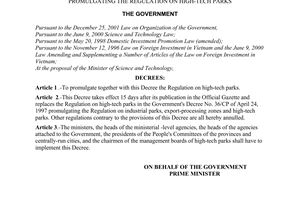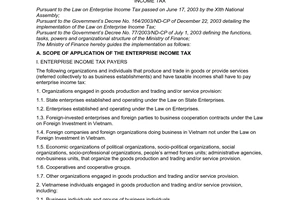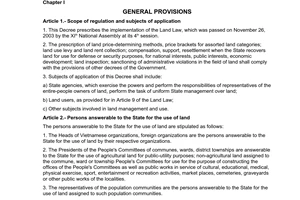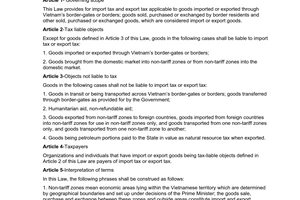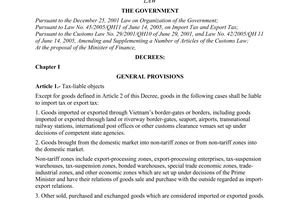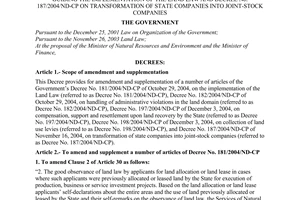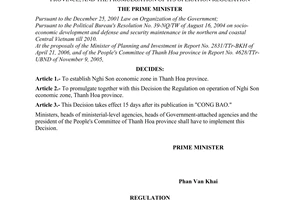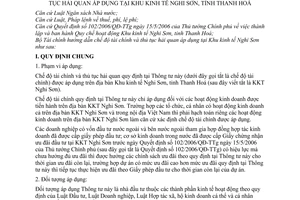Nội dung toàn văn Circular No. 08/2007/TT-BTC guiding financial regimes and customs procedures
|
THE MINISTRY
OF FINANCE |
SOCIALIST REPUBLIC OF VIET NAM |
|
No. 08/2007/TT-BTC |
Hanoi, January 30, 2007 |
CIRCULAR
GUIDING THE FINANCIAL REGIME AND CUSTOMS PROCEDURES APPLICABLE TO NGHI SON ECONOMIC ZONE – THANH HOA PROVINCE
Pursuant to the Law on State budget;
Pursuant to the Law and the Ordinance on Tax, Fees and Charges;
Pursuant to the Prime Minister’s Decision No. 102/2006/QĐ-TTg dated May 15th 2006 on the establishment and the Operation regulation of Nghi Son Economic Zone – Thanh Hoa province;
The Ministry of Finance guides the financial regime and customs procedures applicable to Nghi Son Economic Zone as follows:
I. GENERAL PROVISIONS
1. Scope of application:
This financial regime and customs procedures in this Circular (hereinafter referred to as financial regime) is applicable to Nghi Son Economic Zone – Thanh Hoa province (hereinafter referred to as Nghi Son Economic Zone)
The financial regime specified in this Circular is only applicable to the business activities within the Nghi Son Economic Zone. The organizations and individuals doing business in both Nghi Son Economic Zone and the Vietnam’s inland area must separately record the business activities done within Nghi Son Economic Zone as the basis for determining the applicable financial regime.
If the foreign-invested enterprises and the foreign partners entering into cooperation contracts that have been issued with the investment license; the domestic business establishments that have been issued with the Certificates of investment incentives in Nghi Son Economic Zone before the Prime Minister’s Decision No. 102/2006/QĐ-TTg dated May 15th 2006 takes effect (hereinafter referred to as the Decision No. 102/2006/QĐ-TTg) have not enjoyed the incentives, they shall be eligible for the incentives prescribed in this Circular for the remaining time; If the incentives of a project is higher that that prescribed in this Circular, the incentives stated in the investment license shall apply to the remaining time.
2. Subjects of application:
This Circular is applicable to investors from economic sectors that operate under the Law on Investment, the Law on Enterprise, the Law on Cooperatives, business households and individuals practicing independently, the organizations and individuals doing business under Vietnam’s law.
3. Interpretation of terms:
The terms in this Circular are construed as follows:
- Non-tariff zones: are geographical areas separated by fences from other functional areas of Nghi Son Economic Zone as prescribed in Article 7 and Article 8 of the Operation regulation of Nghi Son Economic Zone promulgated together with the Decision No. 102/2006/QĐ-TTg.
- The functional areas comprise the industrial area, port and logistics area, tourism and recreation area, residential area, and center urban area in Nghi Son Economic Zone (not including export processing zones) determined in the general planning for Nghi Son Economic Zone approved by the Prime Minister.
- Vietnam’s inland area: comprising the functional areas in Nghi Son Economic Zone and the rest of the Vietnam’s territory (except for the non-tariff zones prescribed in Clause 1, Article 5 of the Law on Export and import tax 2005, and in Clause 2, Article 1 of the Decree No. 149/2005/NĐ-CP dated December 08th 2005, hereinafter referred to as other non-tariff zones)
- Customs control gates: A non-tariff zone has 2 customs control gates: a customs control gate is in the area between the non-tariff port and the sea, hereinafter referred to as gate A; the other is adjacent to the non-tariff port and the inland area, hereinafter referred to as gate B.
- The list of goods from the non-tariff zone: is the list of goods periodically made by the management board of Nghi Son Economic Zone (hereinafter referred to as the management board), including the goods manufactured, processed, recycled, and assembled in the non-tariff zone without using materials and parts imported from abroad.
4. The conditions for applying the financial regime related to non-tariff zones:
The financial applicable to the non-tariff zone in Nghi Son Economic Zone is only applicable when the non-tariff zone satisfy the following conditions:
- Having sturdy fences to separate the activities in the non-tariff zone with other functional areas in Nghi Son Economic Zone;
- The is no residential areas, no regular nor irregular residents in non-tariff zones (including foreigners);
- Having customs authority to supervise and inspect people, goods, and vehicles entering and leaving the non-tariff zone.
5. Some general provisions on customs procedures in the non-tariff zone:
a) The organizations and individuals doing business in non-tariff zones may export and import the goods and services that are not prohibited by Vietnam’s law. The policies on exports and imports must comply with the Prime Minister’s provisions on the management of goods export and import in each period, and the guiding documents from relevant Ministries and sectors. The export and import of goods in the list of conditional exports and imports, and goods subject to restricted trading mist comply with the guidance from the Ministry of Trade.
b) Every 6 months, the enterprises in the non-tariff zone must send the report on supplies, materials, exports, and imports in the period, and the report on the inventory to the customs. The customs must check and send them to the tax authority for calculating the taxes payable.
c) The goods and luggage exported, imported and in transit; the means of transport exported, imported, and in transit in non-tariff zones must follow the customs procedures particularly applicable to them.
d) The goods exported, imported and in transit; the means of transport exported, imported, and in transit in non-tariff zones may only go through gate A and gate B.
dd) The goods from abroad through gate B, and the goods exported to the non-tariff zone from Vietnam and vice versa, that go through the customs procedures at gate B; the goods from abroad to the non-tariff zone and from the non-tariff zone to abroad through gate A shall go through the customs procedures at gate A.
e) The goods from Vietnam exported to abroad through gate A, or goods from abroad to Vietnam through gate A, shall go through the customs procedures as prescribed by current law provisions at gate A or a sub-department of customs outside the border-gate area. When going through the procedures at a sub-department of customs outside the border-gate area, the customs procedures must comply with provisions on goods being moved outside the border-gate area.
f) Apart from the provisions on customs procedures stated above, the relevant parties must fulfill other obligations as prescribed by the Law on Customs, the Law on Export and import tax, and other documents related to the export and import.
6. Investment incentive principles:
The projects of investment in Nghi Son Economic Zone are eligible for greatest incentives applicable to projects of investment in localities facing extreme socio-economic difficulties prescribed by the Law on Investment, the Law on Enterprise income tax, the Law on Value-added tax, and other incentives in International Agreements, bilateral and multilateral commercial contracts to which Vietnam is a signatory.
In case various legal documents provide various incentives for one issue, the superior legal document shall apply.
In case various legal documents issued by the same agency provide various incentives for one issue, the latest legal document shall apply.
II. SPECIFIC PROVISIONS
1. Tax policy on Nghi Son Economic Zone:
1.1. Enterprise income tax:
a) The projects of investment of Vietnamese and foreign organizations and individuals in new production and business establishments in Nghi Son Economic Zone are eligible for the enterprise income tax rate of 10% for 15 years as from the commencement of the projects of investment; exempted from enterprise income tax for 04 years as from earning taxable income; eligible for 50% reduction in the tax payable for the next 09 years.
b) The projects of investment of Vietnamese and foreign organizations and individuals in Nghi Son Economic Zone belonging to hi-tech disciplines that satisfy Clause 2 Article 5 of the Government's Decree No. 99/2003/NĐ-CP dated August 28th 2003, promulgating the Regulation on Hi-tech zones; the large projects of investment of Vietnamese and foreign organizations and individuals in Nghi Son Economic Zone, that are highly significant to the sectoral development or the local socio-economic development, are eligible for the enterprise income tax rate of 10% during the entire execution of the project.
c) The production and business establishments investing in new production lines, expanding their scale, technological innovation, ecological improvement, and enhancing their productivities, shall apply current law provisions.
d) The taxable income from the transfer of the right to use or to rent land is subject to income tax as guided in Part C of the Circular No. 128/2003/TT-BTC dated December 22nd 2003 of the Ministry of Finance, guiding the implementation of the Government's Decree No. 164/2003/NĐ-CP dated December 22nd 2003, detailing the implementation of the Law on Enterprise income tax.
dd) To enjoy the enterprise income tax incentives, the organizations and individuals having projects of investment in Nghi Son Economic Zone must submit the copies of their Certificates of business registration (for Vietnamese enterprises), investment licenses (for foreign-invested enterprises) to the tax authority where they declare and pay tax. The enterprise income tax incentives are only applicable to production and business establishments that fully comply with the regime for accounting and invoices, and have declared and paid tax.
e) During the operation, if an enterprise suffers loss after the finalization, it may transfer the loss to the succeeding years to deduct them from taxable income. The loss transfer period must not exceed 5 years.
f) Enterprises must register the period of enterprise income tax exemption or reduction with the tax authority where they declare and pay tax.
1.2. Export tax and import tax:
a) The exported and imported goods in the following cases are exempted from export tax and import tax:
- The goods exported to abroad from the non-tariff zone; the goods imported to the non-tariff zone from abroad that is only be used within the non-tariff zone;
- The goods from a non-tariff zone transferred or sold to other non-tariff zones and vice versa.
- Other goods exempted from export tax imported to the non-tariff zone from the Vietnam’s inland area.
b) The goods subject to export tax imported to the non-tariff zone from the Vietnam’s inland area must pay tax and follow the export procedures as prescribed by current law provisions.
c) The goods imported to the Vietnam’s inland area from a non-tariff zones subject to import tax include:
- Goods imported from abroad must pay import tax as prescribed by current law provisions.
- The goods manufactured, processed, recycled, and assemble within the non-tariff zone is eligible for the preferential import tax rates CEPT if all the conditions as prescribed by current law provisions are satisfied.
- The goods in the List of goods from the non-tariff zone being taken to the inland area is exempted from paying import tax.
- When importing the goods manufactured, processed, recycled, and assemble within the non-tariff zone in Nghi Son Economic Zone that use materials and parts directly imported from abroad (excluding goods imported from the Vietnam’s inland area that use materials and parts imported from abroad) to the Vietnam’s inland area, only the materials and part imported from abroad, that make up such goods, are subject to import tax.
The bases for calculating the import tax payable on the materials and parts imported from abroad, that make up the goods imported to the Vietnam’s inland area, are:
The taxable is calculated as prescribed by current law provisions; the quantity of goods imported to the Vietnam’s inland area; the import tax rate on each kind of materials and parts. The applied taxable prices and tax rates at the time of making the import declaration. Manufacturers and traders must register the list of goods imported as materials for producing goods imported to the inland area, and the limit of materials and parts used for producing imported goods, to the customs before they are imported to the Vietnam’s inland area.
The value of imported materials and parts imported that make up a unit of goods imported to the inland area are calculated in accordance with the provisions on prices for calculating import tax applicable to imported goods at the time of being imported to the Vietnam’s inland area.
d) The projects of investment of Vietnamese and foreign organizations and individuals are exempted from paying the import tax on materials, parts, and semi-finished products, that are not able to be produced at home, for 5 years as from commencing the production.
The procedures for and dossiers on the exemption, declaration, and finalization of import tax in this case must comply with the Law on Export and import tax; the Decree No. 149/2005/NĐ-CP dated December 08th 2005 and the Circular No. 113/2005/TT-BTC dated December 15th 2005 of the Ministry of Finance, guiding the export and import tax.
dd) The Vietnamese and foreign organizations and individuals engaged in production and business in the non-tariff zone that import materials and goods from abroad may sell the remainder and the by-products that have commercial value to the Vietnam’s inland area after completing the customs procedures, and must pay import tax as prescribed by current law provisions.
1.3. Special excise duty:
a. The goods and services subject to special excise duty being produced and sold in the non-tariff zone, or imported to the non-tariff zone from abroad and vice versa, are exempted from special excise duty. Cars with less than 24 seats are subject to special excise duty as prescribed by current provisions.
b. The goods and services subject to special excise duty being exported to the non-tariff zone from the Vietnam’s inland area are exempted from special excise duty. Cars with less than 24 seats are subject to special excise duty as prescribed by current provisions.
c. The goods and services subject to special excise duty being transferred or sold to other non-tariff zones, and vice versa, are exempted from special excise duty.
d. The goods and services subject to special excise duty being imported to the Vietnam’s inland area from the non-tariff zone are not exempted from special excise duty on imported goods as prescribed by current law provisions.
1.4. Value-added tax (VAT):
The enterprises in Nghi Son Economic Zone may use VAT invoices as prescribed by current law provisions, register, declare and pay VAT as prescribed in this Circular. For goods exempted from VAT, the line “value-added tax” in the VAT voice is marked with an (x). In particular:
a) The goods and services being produced and sold within the non-tariff zone, and imported to the non-tariff zone from abroad and vice versa, are exempted from VAT.
The goods transferred or sold to other non-tariff zones from the non-tariff zone and vice versa are exempted from VAT.
c) Goods and services exported to the non-tariff zone from the Vietnam’s inland area are eligible for the VAT rate of 0%..
d) The goods and services being imported to the Vietnam’s inland area from the non-tariff zone are subject to VAT on imported goods as prescribed by current law provisions. In particular, when an enterprise in the non-tariff zone sells to an enterprise, organization, or individual in the Vietnam’s inland area, it shall make an invoice without VAT, the line "tax rate" and "VAT" are marked with (x). Enterprises, organizations, individuals from the inland area (or enterprises in the non-tariff zone in Nghi Son Economic Zone that take and sell goods in the inland area) only pay VAT on the imported goods under the customs declaration sheet when going through the procedures for importing in the domestic market.
1.5. Prices, fees, charges, and other taxes:
a) The land rent prices of land that has technical infrastructures, the rent for the use of technical infrastructures, facilities, and public amenities in Nghi Son Economic Zone are decided by the enterprises that provide such infrastructures after reaching an agreement with the management board of Nghi Son Economic Zone.
b) Other taxes, fees and charges must comply with laws and the Ordinance on Taxes, Fees and Charges, the Law on Investment, and their guiding documents.
2. The customs procedures for goods entering and leaving the non-tariff zone:
2.1. For goods imported to the non-tariff zone from abroad:
a) Imported to the non-tariff zone through gate A:
- The importers must make customs declaration and submit the customs dossiers in accordance with current provisions, according to the forms of goods import prescribed in Clause 5, section I of this Circular.
- The Customs at gate A must complete the necessary procedures for each kind of goods as prescribed by current law provisions.
b) Imported to the non-tariff zone through gate A: Comply with current law provisions on imported goods in transit
2.2. For the goods from Vietnam imported from abroad to the Vietnam’s inland area through gate A, and goods exported from the inland area to abroad through gate A: apply current provisions.
2.3. For goods exported to the non-tariff zone from the inland area:
a) A manufacturer or trader in the inland area that follows the customs procedures at gate B must make customs declaration and submit the customs dossiers as prescribed depending on the form of export. For internal transport of goods between the enterprise and its branches inside or outside the non-tariff zone, the sale contract may be replaced with a delivery note. The customs at gate B must complete the export procedures for them as prescribed.
b) When a manufacturer or trader in the inland area that make the export declaration at the border-gate of the inland sub-department of customs: complete the customs procedures for exported goods being moved outside the border-gate area as prescribed by current law provisions. The customs at gate B must perform the duties of the exporting border-gate customs for the exported goods being moved outside the border-gate area (except for the export confirmation).
2.4. For goods exported to abroad from the non-tariff zone:
a) Through gate A: Comply with current law provisions on exported goods being moved outside the border-gate area.
b) Through gate A: go through the procedures at the customs of gate A. The customs at gate A must complete the customs procedures for exported goods as prescribed by current law provisions.
2.5. For goods from the non-tariff zone to the inland area:
a) The goods in the List of goods from non-tariff zones are exempted from customs procedures, but the goods quantity must be declared to the customs, and subject to the customs’ supervision.
b) Complete the customs procedures for other goods, in particular:
- The manufacturers and traders in the non-tariff zone (the seller) must provide the inland manufacturers or traders (the buyer) with all documents, invoices, and papers as prescribed by the customs so that the inland enterprise can make customs declaration and submit the customs dossier according to the form of import to the customs at gate B.
- The customs at gate B must complete the customs procedures for imported goods of the inland enterprise as prescribed. When it is discovered that the foreign goods being taken into the non-tariff zone to be imported to the inland area is of the same kind with the goods in the List of goods from the non-tariff zone announce by the management board Nghi Son Economic Zone but the enterprise fails to declare with the customs, the customs at gate B shall request the documents proving the origin of the consignment, handle the violations, and complete the import procedures for the consignment as prescribed by law, and notify the management board of Nghi Son Economic Zone so that they can manage or remove them from the List of goods from the non-tariff zone.
2.6. For processed goods:
The customs procedures for goods being processed by manufacturers and traders in the non-tariff zone for foreign traders, or by inland manufacturers and traders, and vice versa, must comply with current law provisions.
2.7. The goods temporarily exported for re-import, temporarily imported for re-export, and in transit:
The goods exported, imported and in transit; the means of transport exported, imported, and in transit in non-tariff zones may only go through that gates with customs control posts. Customs procedures for goods temporarily exported for re-import, temporary import for re-export, and in transit in the non-tariff zone must comply with current provisions.
2.8. Apart from the guidance in this Circular, enterprises must fulfill other obligations as prescribed by the Law on Customs, the Law on Export and import tax, and other documents on customs.
3. Rewarding contributors to the capital mobilization at home or overseas
3.1. Depending on the budget and efficiency of capital attraction, the President of the People’s Committee of Thanh Hoa province shall make decisions on giving rewards to organizations and individuals that contribute to the raise of development capital, to the mobilization of Vietnamese and foreign projects of investment in Nghi Son Economic Zone after obtaining the consent from the Ministry of Finance, as long as the reward for the raise of non-refundable investment is higher than that for other forms of capital raise. The reward is provided after the project comes into operation, launches products on to the market, and the investor has contributed at least 50% of the committed legal capital.
3.2. The budget for giving rewards to contributors to capital raise (not including the capital from the State budget) to invest in economic and social constructions in Nghi Son Economic Zone is extracted from the reward fund of the local budget, and shall be record in the irregular reward index.
4. Preferential regimes for developing infrastructure
4.1. Investment support from the State budget to build infrastructure:
a) Scope and subjects of investment from the State budget
- The State budget shall support the investment in building socio-technical infrastructures, facilities and public amenities serving Nghi Son Economic Zone according to the targeted programs allocated under the estimate approved by competent authorities. The State budget only support the construction of the general infrastructure of Nghi Son Economic Zone, not the separate infrastructure of each functional area in Nghi Son Economic Zone, except for the support for investment in building concentrated sewage and waste treatment facilities of functional areas, and support the compensation for land clearance in functional areas a enterprises resettlement of families whose land is taken.
- The investment support from the State budget to build infrastructure of Nghi Son Economic Zone must comply with the project, in accordance with the planning approved by competent authorities.
- The management board of Nghi Son Economic Zone is the focal point of planning of the locality and may separate the fundamental construction capital from the State budget to build the infrastructure of Nghi Son Economic Zone; is the investor that directly mange the projects of investment in building infrastructure and may invest in the building from the State budget within Nghi Son Economic Zone in accordance with current provisions on construction investment management.
b) Investment support from the State budget to build infrastructure
- Annually, depending on the projects of investment in socio-economic infrastructure approved by competent authorities, the progress of projects, the central budget that support the budget of Thanh Hoa province to invest in the infrastructures of Nghi Son Economic Zone as prescribed by the Law on State budget.
- The central budget that support the budget of Thanh Hoa province to invest in socio-economic infrastructures, the facilities, and public amenities of Nghi Son Economic Zone are specified in the State budget allocation given to Thanh Hoa province. Together with the support from the central budget, Thanh Hoa province must allocate local budget for investing in socio-economic infrastructures, the facilities, and public amenities of Nghi Son Economic Zone as prescribed in Point a this Clause.
c) The receipts earned locally must be paid to the State budget. The receipts of central budget and local budget are separated as prescribed by current law provisions.
d. The management and use of capital supported by the State budget to invest in building infrastructure of Nghi Son Economic Zone:
The capital supported by the State budget for building infrastructure of Nghi Son Economic Zone is managed and used in accordance with provisions on management of investment in fundamental construction, the Law on State budget, and current guiding documents. The estimates are made in accordance with the Law on State budget.
4.2. The regime for using land to create capital for developing infrastructure:
The management board is the focal point and the investor that directly manage the projects using the capital from the land in Nghi Son Economic Zone; that hold bidding to choose an experienced, reputable, and financially capable to execute the projects of infrastructure invested by the capital from the land in Nghi Son Economic Zone.
The management board shall make and send the Service of Finance and the Service of Planning and Investment a list of projects of investment in building infrastructure allowed to use the land to create capital, and the size of the land used to create the capital for the project execution as prescribed by the Law on State budget, so that the People’s Committee of Thanh Hoa may request the People’s Council to decide.
Depending on the local land use planning of, the collection of land levy and land rents from auctions and not from auctions, the compensation paid to people whose land is taken, and the need for investment in infrastructures being the subjects of investment from the State budget as prescribed by law, the People’s Committee of Thanh Hoa province shall direct financial agencies to summarize the receipts and expenses in the annual budget estimates and send them to the People’s Council at the same level for decision.
Depending on the annual budget estimate decided by the People’s Council, the People’s Committee shall appoint a financial agency to cooperate with relevant units in organizing the receipts and expenses from the land levy and land rent, and record them to the State budget under the provided regime.
If an organization or individual pays in advance the compensation to the people whose land is taken to invest in infrastructure being the subjects of investment from the State budget, and holds the auctions to collect land levy and land rent later, the land levy and land rent collected to be returned to the organization or individual that paid in advance must be completely recorded to the State budget as prescribed by current law provisions.
The use of land to create capital for building infrastructure of Nghi Son Economic Zone must comply with the Government's Decree No. 181/2004/NĐ-CP dated October 29th 2004 on the implementation of the Law on land, the Government's Decree No. 17/2006/NĐ-CP dated January 27th 2006, amending and supplementing a number of articles of the Decrees guiding the implementation of the Law on Land, the Prime Minister’s Decision No. 216/2005/QĐ-TTg dated August 31st 2005, promulgating the regime for bidding land tenancy to allocate land subject to land levies or to rent land, and other relevant law provisions.
4.3. Investing in infrastructure from ODA and other capital sources:
The necessary socio-technical infrastructures, public amenities and facilities of Nghi Son Economic Zone, and other technical amenities shall be prioritized to be included in the List of ODA mobilization, and may employ other method of capital mobilization as prescribed in Article 21 of the Regulation of Nghi Son Economic Zone promulgated together with the Decision No. 102/2006/QĐ-TTg.
5. The Financial regime applicable to the management board of Nghi Son Economic Zone:
5.1. The management board is a local unit of budget estimates. The budget of the management board is funded by the local budget. All amounts collected by the management board must be paid to the State budget as prescribed.
5.2. The management board may collect fees and charges corresponding to the duties assigned by State management agencies as prescribed by current provisions. When being delegated to collect money by a competent State agency, the management board must notify and register with the tax authority where its head office is located to go through the procedures for paying the fees and charges collected while performing the delegated duties.
III. IMPLEMENTATION ORGANIZATION
1. The People’s Committee of Thanh Hoa province must ensure the fulfillment of the conditions prescribed in Clause 4, Section I so that the non-tariff zone may apply the financial regime prescribed in this Circular. Otherwise, the application is not allowed.
2. The General Department of Customs must:
Prescribe the customs procedures applicable to the non-tariff zone in Nghi Son Economic Zone based on the provisions on customs procedures in this Circular and the current customs procedures applicable to non-tariff zones.
3. The Customs of Thanh Hoa province must:
- Organize the prevention of smuggling and trade fraud, prevent the illegal import of goods from the non-tariff zone to the Vietnam’s inland area and at other places under their management.
- Cooperate with the management board of the economic zone and relevant agencies (the tax authority, the police, the border guard) in the prevention of smuggling and trade fraud, prevent the illegal import of goods from the non-tariff zone to the Vietnam’s inland area.
- Inspect and supervise goods and means of transport, prevent smuggling and illegal transport of goods across the border; organize the implementation of law provisions on law applicable to exports and imports; organize the customs posts favorable to the geographical characteristics of the non-tariff zone in order to fulfill the assigned duties.
4. The Tax department of Thanh Hoa province must instruct to implement Point e, Clause 1.1, Section II of this Circular and other provisions on tax.
5. This Circular takes effect after 15 days as from the date of its publication on the Official Gazette. It is recommended to report the difficulties arising during the course of implementation to the Ministry of Finance for consideration and settlement./.
|
|
FOR THE MINISTER |
------------------------------------------------------------------------------------------------------
This translation is made by LawSoft,
for reference only. LawSoft
is protected by copyright under clause 2, article 14 of the Law on Intellectual Property. LawSoft
always welcome your comments


